
As the second cultural highlight of Mantapa Prabhakara Upadhya’s 1000th Performance of Ekavyakti Yakshagana celebration we were treated with Kathakali performance by Mudrakhya of Palakkad. Mudrakhya is an organisation established to work for the cause of Kathakali & related art forms of Kerala.

Before the actual performance Kathakali there was a lecture demonstration on the various abhinaya aspect of Kathakali by manager of Mudrakhya team K. Shashi and Sadanam Krishnadas. This demonstration helped us, who had very little knowledge about this art form to understand gestures of Kathakali.

It was followed by beautiful rendition of Narakasura by K.M Nandakumar Nair who has spent over 50 years practicing Kathakali.

Nandakumaran born in 1945, hails from the serene village of Desamangalam. Nandkumaran learned the art of Ottanthullal during the 1954-59 under Kalamandalam Divakaran Nair & Malabar Kannan Nair, the senior instructors at the Kerala Kalamandalam, Chruthuruthy, Kerala.

His training in Kathakali commenced in 1963, at the PSV Natyasangham, Kottakkal, under the tutelage of Kottakkal Krishnankutty Nair. After his student days, Nandakumaran served the PSV Natyasangham as a performer and a teacher till 1998. He still continues to be a free lance performer, teacher and resource person of Kathakali.

Distribution of the task of elucidating emotions to the entire body is the observed uniqueness of Kathakali. This very specific technique separates Kathakali from its parallel forms like Koodiyattom & Krishnanattom. This was perfectly elucidated by Nandakumaran in Narakasura

Katha = Story. Kali = play. Even though it is not the rigid meaning related to theatre it is just enacting a story. The text for this purpose is referred to as Aattakkatha meaning a story written to be produced as a Kathakali.

Kathakali as we see today is just more than four centuries old. The popular legend behind Kathakali may be quickly reviewed to establish that there was a great revolutionary and socialistic philosophy that played into the evolution of Kathakali. Zamorin, a local chieftain in the northern Kerala was a patron of Krishnanattom, essentially a dance drama that deals only with the story of Krishna, only within the premises of Krishna-temples.

A local chieftain from Kottarakkara, southern Kerala, invited the Zamorin to present Krishnanattom in Kottarakkara. This was turned down by the Zamorin, with a statement that Krishnanattom is not for the unscholarly audience of southern Kerala. With a vengeance, the royal chieftain of Kottarakkara gave rise to Ramanattom. Ramanattom enacted stories from Ramayana and other epics also. In due course of time, as it began to encompass many stories, Ramanattom evolved into a medium with bigger dimension, to ‘Play any Story’ thus becoming Kathakali.

Nanadakumaran was amply assisted in background score by A. M Ravindran and Sadanam Jothish Babu in vocals, Kalamandala jayakrishna and Krishna Praveen Poduval in Chande, Srijith Marar in Maddale.

Capturing very fine movement and expressions of Kathakali was a great challenge to me. Using two dimensional still medium like photography to depict vibrant art form of Kathakali that too on a stage cluttered with huge distracting writing in the background was really a challenge. Video would show the finer movements but how to get that in Photography. I tried in this photograph by shooting with very low shutter speed (1/25th of a second). You will notice that only the right hand of Narakasura and Chende stick are mobile in the photograph with rest of the picture are still thus conveying a very subtle movement of the artist.



Superb series Krishi
Very relevant post. Nandakumaran is a true Kathakali artist (as I have understood what Kathakali is, in my own humble way). He never tries to intentionally capture the good will of the ‘self claimed connoisseres groups’. Thus, he is not in the panel of the imposed glamourous ones, The demonstarion picture of Krishnadas is well framed.